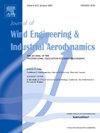Numerical study of turbulent flows over complex terrain using an unsteady Reynolds-averaged Navier-Stokes model with a new method for turbulent inflow generation
IF 4.2
2区 工程技术
Q1 ENGINEERING, CIVIL
Journal of Wind Engineering and Industrial Aerodynamics
Pub Date : 2025-02-01
DOI:10.1016/j.jweia.2024.105991
引用次数: 0
Abstract
In this study, an unsteady Reynolds-Averaged Navier-Stokes (URANS) model with a prespecified averaging time and a new method for turbulent inflow generation is proposed to predict turbulent flows over complex terrain. Firstly, the effect of grid resolution on turbulent flows over complex terrain is investigated by the Reynolds-Averaged Navier-Stokes (RANS) and the URANS models. URANS improves the accuracy of the predicted mean velocity and standard deviation by using finer grids, but the improvement by RANS is limited. Furthermore, the turbulent flows over hills with different slopes predicted by URANS are examined with respect to various averaging times. An optimal averaging time based on the slope of the hills is recommended considering the prediction accuracy and computational efficiency of URANS. Finally, turbulent flows over complex terrain in coastal areas are investigated by URANS and validated by wind tunnel tests. The predicted mean and standard deviation of streamwise velocity over complex terrain by URANS are in good agreement with the experimental data, while those by RANS are overestimated or underestimated.
基于非定常reynolds -average Navier-Stokes模型的复杂地形紊流数值研究与紊流产生新方法
本文提出了一种具有预定平均时间的非定常reynolds - average Navier-Stokes (URANS)模型和一种新的湍流流入生成方法,用于预测复杂地形上的湍流流动。首先,利用reynolds - average Navier-Stokes (RANS)模型和URANS模型研究了网格分辨率对复杂地形湍流的影响。URANS通过使用更精细的网格来提高平均速度和标准差的预测精度,但其提高是有限的。此外,还研究了URANS预测的不同坡度山丘上的湍流在不同平均时间下的变化。考虑到URANS的预测精度和计算效率,提出了基于山丘坡度的最优平均时间。最后,利用URANS对沿海地区复杂地形上的湍流流动进行了研究,并通过风洞试验进行了验证。URANS预测的复杂地形下的流速均值和标准差与实验数据吻合较好,但存在过高或过低的情况。
本文章由计算机程序翻译,如有差异,请以英文原文为准。
求助全文
约1分钟内获得全文
求助全文
来源期刊
CiteScore
8.90
自引率
22.90%
发文量
306
审稿时长
4.4 months
期刊介绍:
The objective of the journal is to provide a means for the publication and interchange of information, on an international basis, on all those aspects of wind engineering that are included in the activities of the International Association for Wind Engineering http://www.iawe.org/. These are: social and economic impact of wind effects; wind characteristics and structure, local wind environments, wind loads and structural response, diffusion, pollutant dispersion and matter transport, wind effects on building heat loss and ventilation, wind effects on transport systems, aerodynamic aspects of wind energy generation, and codification of wind effects.
Papers on these subjects describing full-scale measurements, wind-tunnel simulation studies, computational or theoretical methods are published, as well as papers dealing with the development of techniques and apparatus for wind engineering experiments.

 求助内容:
求助内容: 应助结果提醒方式:
应助结果提醒方式:


